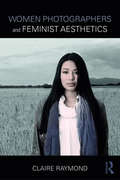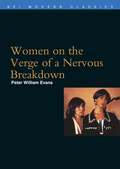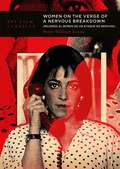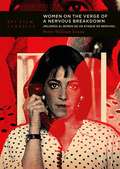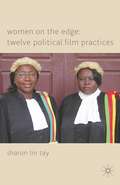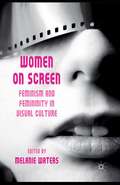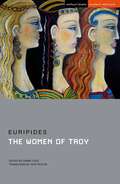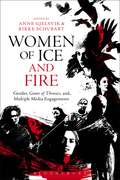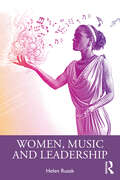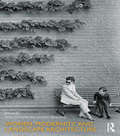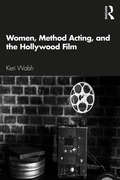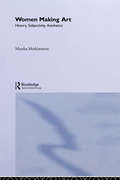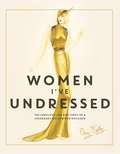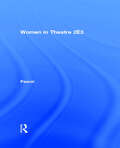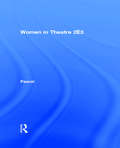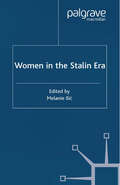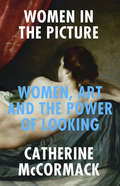- Table View
- List View
Women Photographers and Feminist Aesthetics
by Claire RaymondWomen Photographers and Feminist Aesthetics makes the case for a feminist aesthetics in photography by analysing key works of twenty-two women photographers, including cis- and trans-woman photographers. Claire Raymond provides close readings of key photographs spanning the history of photography, from nineteenth-century Europe to twenty-first century Africa and Asia. She offers original interpretations of well-known photographers such as Diane Arbus, Sally Mann, and Carrie Mae Weems, analysing their work in relation to gender, class, and race. The book also pays close attention to the way in which indigenous North Americans have been represented through photography and the ways in which contemporary Native American women photographers respond to this history. Developing the argument that through aesthetic force emerges the truly political, the book moves beyond polarization of the aesthetic and the cultural. Instead, photographic works are read for their subversive political and cultural force, as it emerges through the aesthetics of the image. This book is ideal for students of Photography, Art History, Art and Visual Culture, and Gender.
Women Photographers and Feminist Aesthetics
by Claire RaymondWomen Photographers and Feminist Aesthetics makes the case for a feminist aesthetics in photography by analysing key works of twenty-two women photographers, including cis- and trans-woman photographers. Claire Raymond provides close readings of key photographs spanning the history of photography, from nineteenth-century Europe to twenty-first century Africa and Asia. She offers original interpretations of well-known photographers such as Diane Arbus, Sally Mann, and Carrie Mae Weems, analysing their work in relation to gender, class, and race. The book also pays close attention to the way in which indigenous North Americans have been represented through photography and the ways in which contemporary Native American women photographers respond to this history. Developing the argument that through aesthetic force emerges the truly political, the book moves beyond polarization of the aesthetic and the cultural. Instead, photographic works are read for their subversive political and cultural force, as it emerges through the aesthetics of the image. This book is ideal for students of Photography, Art History, Art and Visual Culture, and Gender.
Women on the Verge of a Nervous Breakdown (BFI Film Classics)
by Peter William EvansThis text analyses director Pedro Almodovar's insights into gender, sexuality and subjectivity in his film Women on the Verge of a Nervous Breakdown. The author draws on a range of psychoanalytic and critical concepts and sees the film as an account of the often tyrannical spell of sexual desire, of the anxieties of relationships and families, but also of the possibilities of personal liberation. Peter William Evans also discusses the recent history of Spain and ties the film's concerns into the social revolution which occurred after the death of Franco.
Women on the Verge of a Nervous Breakdown (BFI Film Classics)
by Peter William EvansThis text analyses director Pedro Almodovar's insights into gender, sexuality and subjectivity in his film Women on the Verge of a Nervous Breakdown. The author draws on a range of psychoanalytic and critical concepts and sees the film as an account of the often tyrannical spell of sexual desire, of the anxieties of relationships and families, but also of the possibilities of personal liberation. Peter William Evans also discusses the recent history of Spain and ties the film's concerns into the social revolution which occurred after the death of Franco.
Women on the Verge of a Nervous Breakdown (BFI Film Classics)
by Peter William EvansPedro Almodóvar's 1988 black comedy-melodrama Women on the Verge of a Nervous Breakdown established its director as one of the most exciting of European film-making talents. An often hilarious study of sexual mores, Women on the Verge has a central character, Pepa (Carmen Maura), as warm and richly drawn as any modern film heroine. Made strong and self-reliant by suffering in a troubled relationship, Pepa is the centre of a network of lovers, friends and family who represent a vivid cross-section of Spanish society. Peter William Evans provides a formidable analysis of Almodóvar's insights into gender, sexuality and identity. Evans sees Women on the Verge as concerned with the often tyrannical spell of sexual desire and the anxieties of relationships and families, but also with the possibilities for personal liberation. He discusses the film in the context of the history of Spain and the social revolution that occurred after the death of Franco. In his foreword to this new edition, Evans reflects upon Women on the Verge in the light of Almodóvar's subsequent films, and the impact of Carmen Maura's performance as Pepa on the representation of women in Spanish cinema.
Women on the Verge of a Nervous Breakdown (BFI Film Classics)
by Peter William EvansPedro Almodóvar's 1988 black comedy-melodrama Women on the Verge of a Nervous Breakdown established its director as one of the most exciting of European film-making talents. An often hilarious study of sexual mores, Women on the Verge has a central character, Pepa (Carmen Maura), as warm and richly drawn as any modern film heroine. Made strong and self-reliant by suffering in a troubled relationship, Pepa is the centre of a network of lovers, friends and family who represent a vivid cross-section of Spanish society. Peter William Evans provides a formidable analysis of Almodóvar's insights into gender, sexuality and identity. Evans sees Women on the Verge as concerned with the often tyrannical spell of sexual desire and the anxieties of relationships and families, but also with the possibilities for personal liberation. He discusses the film in the context of the history of Spain and the social revolution that occurred after the death of Franco. In his foreword to this new edition, Evans reflects upon Women on the Verge in the light of Almodóvar's subsequent films, and the impact of Carmen Maura's performance as Pepa on the representation of women in Spanish cinema.
Women on the Edge: Twelve Political Film Practices
by S. TayWomen on the Edge re-envisions women's cinema as contemporary political practices by exploring the works of twelve filmmakers. Moving on from the 1970s feminist adage that the personal is political, Sharon Lin Tay argues that contemporary women's cinema must exceed the personal to be politically relevant and ethically cogent.
Women on Screen: Feminism and Femininity in Visual Culture
by Melanie WatersA timely intervention into debates on the representation of feminist and feminine identities in contemporary visual culture. The essays in this collection interrogate how and why certain formulations of feminism and femininity are currently prevalent in mainstream cinema and television, offering new insights into postfeminist media phenomena.
The Women of Troy (Student Editions)
by EuripidesThere's no decent way to say an indecent thingAn industrial port of a war-torn city. Women survivors wait to be shipped abroad. Officials come and go. A grandmother, once queen, watches as her remaining family are taken from her one by one. The city burns around them. First performed in 415BC, the play focuses on the human cost of war and the impact of loss.This new Student Edition of The Women of Troy includes a commentary and notes by Emma Cole, which looks at the Trojan War as represented in Greek literature and myth; the context in which Euripides was writing and within which the play was first performed; how it would have been originally staged and dramaturgical challenges met; as well as recent performance history of the play, including Katie Mitchell's iconic 2007 production at the National Theatre. Euripides' great anti-war play is published here in Don Taylor's classic translation.
The Women of Troy (Student Editions)
by EuripidesThere's no decent way to say an indecent thingAn industrial port of a war-torn city. Women survivors wait to be shipped abroad. Officials come and go. A grandmother, once queen, watches as her remaining family are taken from her one by one. The city burns around them. First performed in 415BC, the play focuses on the human cost of war and the impact of loss.This new Student Edition of The Women of Troy includes a commentary and notes by Emma Cole, which looks at the Trojan War as represented in Greek literature and myth; the context in which Euripides was writing and within which the play was first performed; how it would have been originally staged and dramaturgical challenges met; as well as recent performance history of the play, including Katie Mitchell's iconic 2007 production at the National Theatre. Euripides' great anti-war play is published here in Don Taylor's classic translation.
Women of Ice and Fire: Gender, Game of Thrones and Multiple Media Engagements (PDF)
by Rikke Schubart Anne GjelsvikGeorge R.R. Martin's acclaimed seven-book fantasy series A Song of Ice and Fire is unique for its strong and multi-faceted female protagonists, from teen queen Daenerys, scheming Queen Cersei, child avenger Arya, knight Brienne, Red Witch Melisandre, and many more. The Game of Thrones universe challenges, exploits, yet also changes how we think of women and gender, not only in fantasy, but in Western culture in general. Divided into three sections addressing questions of adaptation from novel to television, female characters, and politics and female audience engagement within the GoT universe, the interdisciplinary and international lineup of contributors analyze gender in relation to female characters and topics such as genre, sex, violence, adaptation, as well as fan reviews. The genre of fantasy was once considered a primarily male territory with male heroes. Women of Ice and Fire shows how the GoT universe challenges, exploits, and reimagines gender and why it holds strong appeal to female readers, audiences, and online participants.
Women of Ice and Fire: Gender, Game of Thrones and Multiple Media Engagements
by Rikke Schubart Anne GjelsvikGeorge R.R. Martin's acclaimed seven-book fantasy series A Song of Ice and Fire is unique for its strong and multi-faceted female protagonists, from teen queen Daenerys, scheming Queen Cersei, child avenger Arya, knight Brienne, Red Witch Melisandre, and many more. The Game of Thrones universe challenges, exploits, yet also changes how we think of women and gender, not only in fantasy, but in Western culture in general. Divided into three sections addressing questions of adaptation from novel to television, female characters, and politics and female audience engagement within the GoT universe, the interdisciplinary and international lineup of contributors analyze gender in relation to female characters and topics such as genre, sex, violence, adaptation, as well as fan reviews. The genre of fantasy was once considered a primarily male territory with male heroes. Women of Ice and Fire shows how the GoT universe challenges, exploits, and reimagines gender and why it holds strong appeal to female readers, audiences, and online participants.
Women, Music and Leadership
by Helen RusakWomen, Music and Leadership offers a wide-ranging survey of women in musical leadership and their experiences, highlighting women’s achievements and considering how they negotiate the challenges of the leadership space in music. Women have always participated in music as performers, teachers, composers and professionals, but remain underrepresented in leadership positions. Covering women’s leadership across a wide variety of roles and musical genres, this book addresses women in classical music, gospel, blues, jazz, popular music, electronic music and non-Western musical contexts, and considers women working as composers, as conductors, and in music management and the music business. Each chapter includes several case studies of women’s careers, exploring their groundbreaking contributions to music and the challenges they faced as leaders. Connecting management theory and leadership research with feminist musicology, this book paints a new picture of women’s major contributions as leaders in music and their ongoing struggles for equity. It will be relevant to students and scholars in arts and music management, as well as all those studying music, gender or leadership, and women music professionals.
Women, Music and Leadership
by Helen RusakWomen, Music and Leadership offers a wide-ranging survey of women in musical leadership and their experiences, highlighting women’s achievements and considering how they negotiate the challenges of the leadership space in music. Women have always participated in music as performers, teachers, composers and professionals, but remain underrepresented in leadership positions. Covering women’s leadership across a wide variety of roles and musical genres, this book addresses women in classical music, gospel, blues, jazz, popular music, electronic music and non-Western musical contexts, and considers women working as composers, as conductors, and in music management and the music business. Each chapter includes several case studies of women’s careers, exploring their groundbreaking contributions to music and the challenges they faced as leaders. Connecting management theory and leadership research with feminist musicology, this book paints a new picture of women’s major contributions as leaders in music and their ongoing struggles for equity. It will be relevant to students and scholars in arts and music management, as well as all those studying music, gender or leadership, and women music professionals.
Women, Modernity, and Landscape Architecture
by Sonja Dümpelmann John BeardsleyModernity was critically important to the formation and evolution of landscape architecture, yet its histories in the discipline are still being written. This book looks closely at the work and influences of some of the least studied figures of the era: established and less well-known female landscape architects who pursued modernist ideals in their designs. The women discussed in this volume belong to the pioneering first two generations of professional landscape architects and were outstanding in the field. They not only developed notable practices but some also became leaders in landscape architectural education as the first professors in the discipline, or prolific lecturers and authors. As early professionals who navigated the world of a male-dominated intellectual and menial work force they were exponents of modernity. In addition, many personalities discussed in this volume were either figures of transition between tradition and modernism (like Silvia Crowe, Maria Teresa Parpagliolo), or they fully embraced and furthered the modernist agenda (like Rosa Kliass, Cornelia Oberlander). The chapters offer new perspectives and contribute to the development of a more balanced and integrated landscape architectural historiography of the twentieth century. Contributions come from practitioners and academics who discuss women based in USA, Canada, Brazil, New Zealand, South Africa, the former USSR, Sweden, Britain, Germany, Austria, France and Italy. Ideal reading for those studying landscape history, women’s studies and cultural geography.
Women, Modernity, and Landscape Architecture
by Sonja Dümpelmann John BeardsleyModernity was critically important to the formation and evolution of landscape architecture, yet its histories in the discipline are still being written. This book looks closely at the work and influences of some of the least studied figures of the era: established and less well-known female landscape architects who pursued modernist ideals in their designs. The women discussed in this volume belong to the pioneering first two generations of professional landscape architects and were outstanding in the field. They not only developed notable practices but some also became leaders in landscape architectural education as the first professors in the discipline, or prolific lecturers and authors. As early professionals who navigated the world of a male-dominated intellectual and menial work force they were exponents of modernity. In addition, many personalities discussed in this volume were either figures of transition between tradition and modernism (like Silvia Crowe, Maria Teresa Parpagliolo), or they fully embraced and furthered the modernist agenda (like Rosa Kliass, Cornelia Oberlander). The chapters offer new perspectives and contribute to the development of a more balanced and integrated landscape architectural historiography of the twentieth century. Contributions come from practitioners and academics who discuss women based in USA, Canada, Brazil, New Zealand, South Africa, the former USSR, Sweden, Britain, Germany, Austria, France and Italy. Ideal reading for those studying landscape history, women’s studies and cultural geography.
Women, Method Acting, and the Hollywood Film
by Keri WalshWomen, Method Acting, and the Hollywood Film is the first study dedicated to understanding the work of female Method actors on film. While Method acting on film has typically been associated with the explosive machismo of actors like Marlon Brando and Robert De Niro, this book explores an alternate tradition within the Method—the work that women from the Actors Studio did in Hollywood. Covering the period from the end of the Second World War until the 1970s, this study shows how the women associated with the Actors Studio increasingly used Method acting in ways that were compatible with their burgeoning feminist political commitments and developed a style of feminist Method acting. The book examines the complex intersection of Method acting, sexuality, and gender by analyzing performances such as Kim Hunter’s in A Streetcar Named Desire, Julie Harris’s in The Member of the Wedding, Shelley Winters’s in The Big Knife, Geraldine Page’s in Sweet Bird of Youth, and Jane Fonda’s in Coming Home. Challenging the longstanding assumption that Method acting’s approaches were harmful to women and incompatible with feminism, this book argues that some of Hollywood’s most interesting female actors, and leading feminists, emerged from the Actors Studio in the period between the 1950s and the 1970s. Written for students and scholars of Film Studies, Cultural Studies, Theatre and Performance Studies, and Gender Studies, Women, Method Acting, and the Hollywood Film reshapes the way we think of a central strain in American screen acting, and in doing so, allows women a new stake in that tradition.
Women, Method Acting, and the Hollywood Film
by Keri WalshWomen, Method Acting, and the Hollywood Film is the first study dedicated to understanding the work of female Method actors on film. While Method acting on film has typically been associated with the explosive machismo of actors like Marlon Brando and Robert De Niro, this book explores an alternate tradition within the Method—the work that women from the Actors Studio did in Hollywood. Covering the period from the end of the Second World War until the 1970s, this study shows how the women associated with the Actors Studio increasingly used Method acting in ways that were compatible with their burgeoning feminist political commitments and developed a style of feminist Method acting. The book examines the complex intersection of Method acting, sexuality, and gender by analyzing performances such as Kim Hunter’s in A Streetcar Named Desire, Julie Harris’s in The Member of the Wedding, Shelley Winters’s in The Big Knife, Geraldine Page’s in Sweet Bird of Youth, and Jane Fonda’s in Coming Home. Challenging the longstanding assumption that Method acting’s approaches were harmful to women and incompatible with feminism, this book argues that some of Hollywood’s most interesting female actors, and leading feminists, emerged from the Actors Studio in the period between the 1950s and the 1970s. Written for students and scholars of Film Studies, Cultural Studies, Theatre and Performance Studies, and Gender Studies, Women, Method Acting, and the Hollywood Film reshapes the way we think of a central strain in American screen acting, and in doing so, allows women a new stake in that tradition.
Women Making Art: History, Subjectivity, Aesthetics
by Marsha MeskimmonWomen have been making art for centuries, yet their work has been seen as secondary or has gone unrecognized altogether. Women Making Art asks why this is so, and what it would take for us to realize the extent of women's extraordinary contribution to the arts. Marsha Meskimmon mobilizes contemporary feminist thinking to reconsider how and why women have made art. She examines work by a wide range of women artists from different cultures and historical periods, including Rebecca Horn, Rachel Whiteread, Shirin Neshat and Maya Lin, emphasizing the diversity of women's art and the importance of differences between women.
Women Making Art: History, Subjectivity, Aesthetics
by Marsha MeskimmonWomen have been making art for centuries, yet their work has been seen as secondary or has gone unrecognized altogether. Women Making Art asks why this is so, and what it would take for us to realize the extent of women's extraordinary contribution to the arts. Marsha Meskimmon mobilizes contemporary feminist thinking to reconsider how and why women have made art. She examines work by a wide range of women artists from different cultures and historical periods, including Rebecca Horn, Rachel Whiteread, Shirin Neshat and Maya Lin, emphasizing the diversity of women's art and the importance of differences between women.
Women I've Undressed: The Fabulous Life and Times of a Legendary Hollywood Designer
by Orry-KellyOrry-Kelly created magic on screen, from Casablanca and The Maltese Falcon to Some Like It Hot. He won three Oscars for costume design. He dressed all the biggest stars, from Bette Davis to Marilyn Monroe. Yet few know who Orry-Kelly really was - until now. Discovered in a pillowcase, Orry-Kelly's long-lost memoirs reveal a wildly talented and cheeky rascal who lived a big life, on and off the set. From his childhood in Kiama to revelling in Sydney's underworld nightlife as a naïve young artist and chasing his dreams of acting in New York, his early life is a wild and exciting ride. Sharing digs in New York with another aspiring actor, Cary Grant, and partying hard in between auditions, he ekes out a living painting murals for speakeasies before graduating to designing stage sets and costumes. When he finally arrives in Hollywood, it's clear his adventures have only just begun. Fearless, funny and outspoken, Orry-Kelly lived life to the full. In Women I've Undressed, he shares a wickedly delicious slice of it.
Women in Theatre 2#3 (Contemporary Theatre Review Ser.)
by Julia PascalFirst Published in 1996. Routledge is an imprint of Taylor & Francis, an informa company.
Women in Theatre 2#3
by Julia PascalFirst Published in 1996. Routledge is an imprint of Taylor & Francis, an informa company.
Women in the Stalin Era (Studies in Russian and East European History and Society)
by Melanie IlicThis book brings together for the first time a collection of essays by western scholars about women in the Stalin era (1928-53). It explores both the realities of women's lived experience in the 1930s and 1940s, and the various forms in which womanhood and femininity were represented and constructed in these decades. Women in the Stalin Era challenges the scholarly neglect women's history has suffered at the hands, and pens, of Russian and western historians of the Stalin period.
Women in the Picture: Women, Art and the Power of Looking
by Catherine McCormackA bold reconsideration of women in art – from the ‘Old Masters’ to the posts of Instagram influencers A perfect pin-up, a damsel in distress, a saintly mother, a femme fatale … Women’s identity has long been stifled by a limited set of archetypes, found everywhere in pictures from art history’s classics to advertising, while women artists have been overlooked and held back from shaping more empowering roles. In this impassioned book, art historian Catherine McCormack asks us to look again at what these images have told us to value, opening up our most loved images – from those of Titian and Botticelli to Picasso and the Pre-Raphaelites. She also shows us how women artists – from Berthe Morisot to Beyoncé, Judy Chicago to Kara Walker – have offered us new ways of thinking about women’s identity, sexuality, race and power. Women in the Picture gives us new ways of seeing the art of the past and the familiar images of today so that we might free women from these restrictive roles and embrace the breadth of women’s vision.
